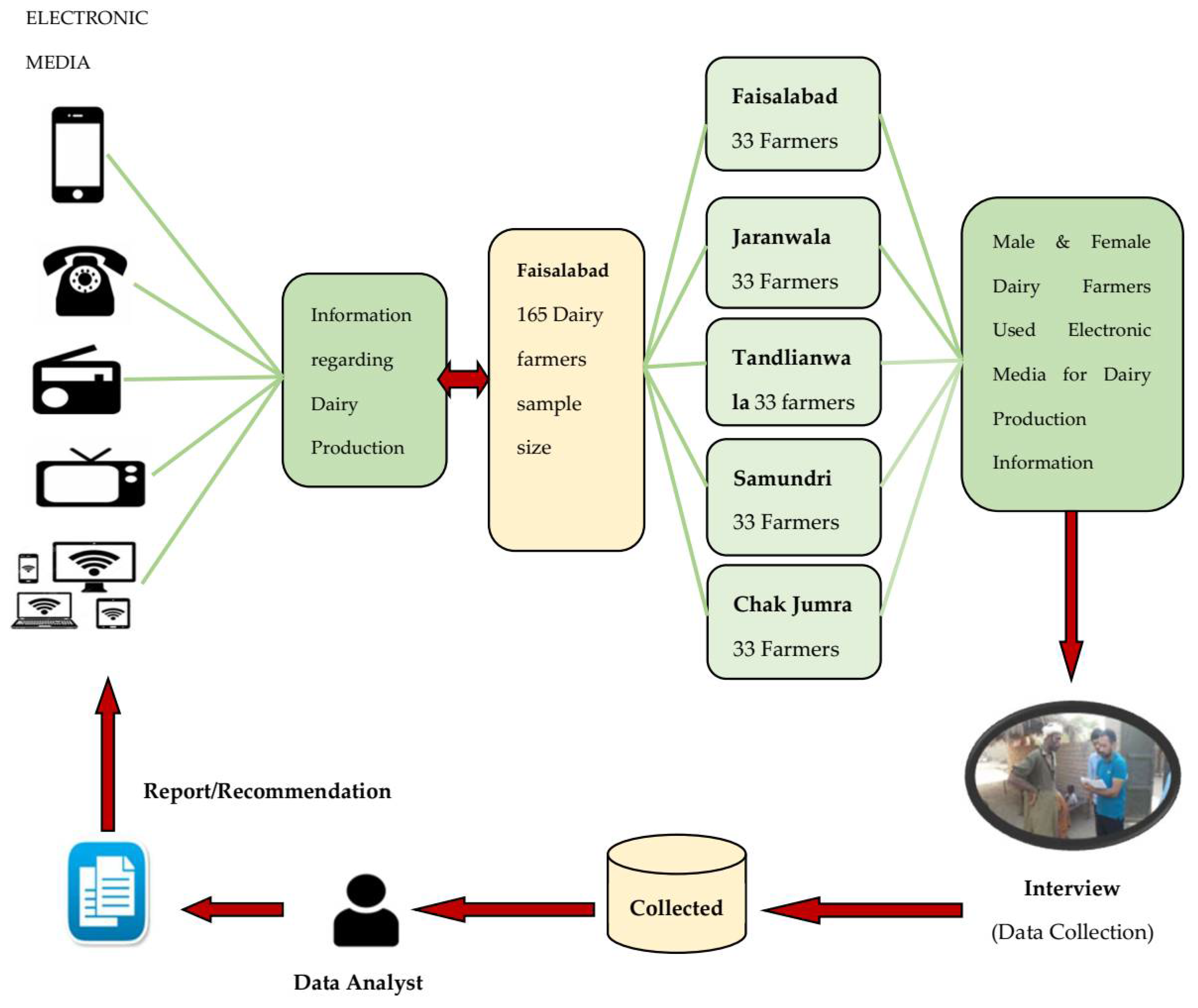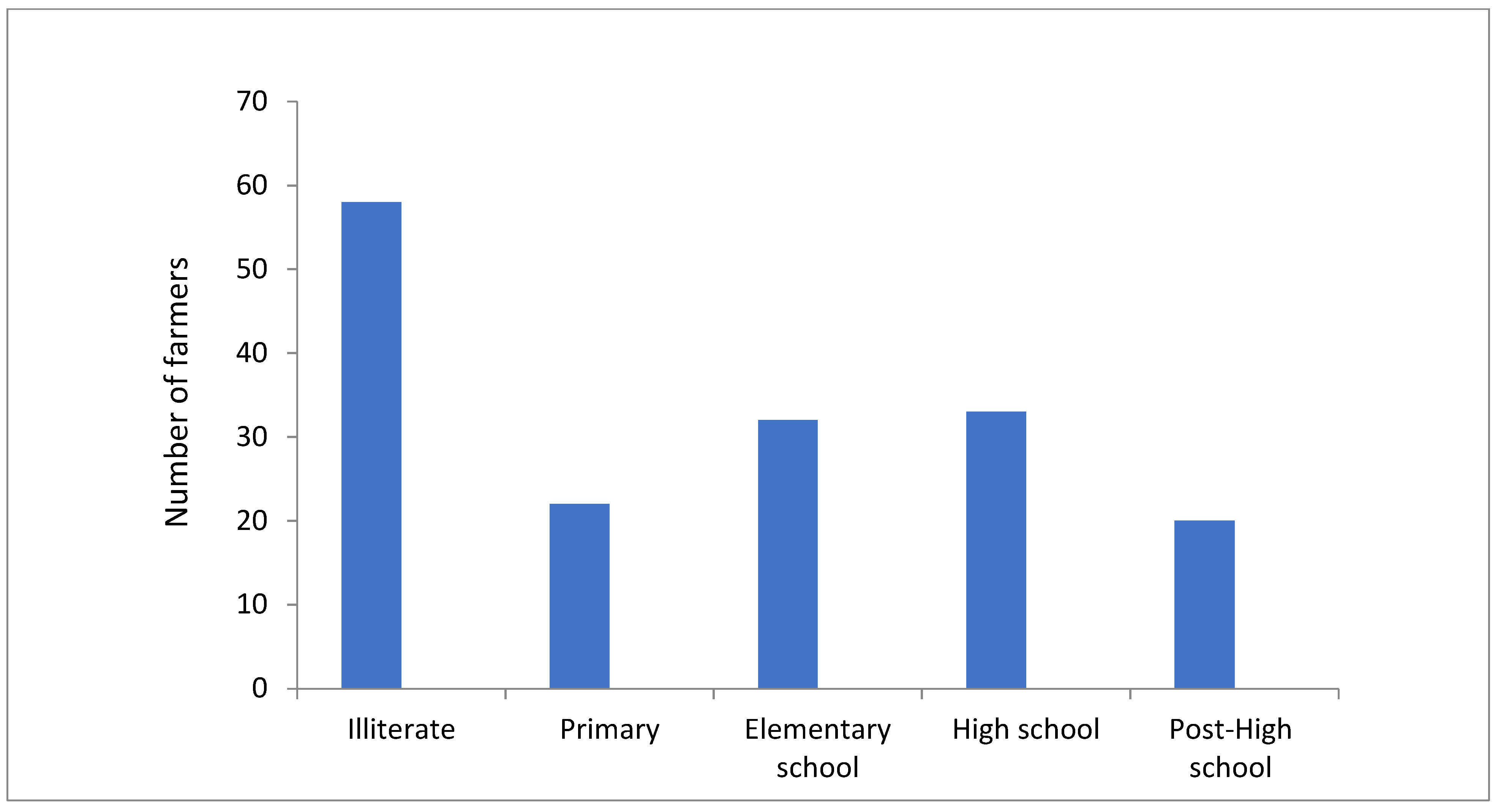1. Introduction
The livestock and dairy sector is a large source of food and income for developing countries around the world. In Pakistan, livestock is the most important subsector of agriculture, with a remarkable contribution of about 50%. For livestock, milk production is the largest commodity and plays an important role in income generation. The average milk yield per cow in Pakistan is 14 L per day [
1].
The households who keep cattle for milk production in the province of Punjab, Pakistan, is 3,550,020. The total number of cattle kept in this province is 14,412,323. The Faisalabad district (study area) contains a total of 147,451 households with cattle and has a total cattle population of 460,632 [
2]. In the category of mixed farming systems, keeping livestock is also the main source of income for rural people and provides productive employment for the poor and rural women [
3]. The dairy industry in Pakistan mostly relies on small farmers who have between three and five milking animals each. About 90% of the livestock farmers in Pakistan are small farmers [
4]. Dairy production is also one of the best ways to earn foreign exchange and maximize revenue to improve and strengthen the economy in developing countries, including Pakistan. The dairy industry also provides a great opportunity for overcoming unemployment, acts as a defense against drought (overcoming food shortages), provides a means of transportation, and provides organic fertilizer for crop production. Landless dairy farmers are totally dependent on this occupation, and they earn income to provide for their families from the sale of milk and animals [
5].
In Pakistan, the dairy sector has many stakeholders in its value chain who depend on it for their livelihoods, including retailers, distributors, processors, transporters, milk collectors, and 6.8 million farmers [
6]. Dairy contributes more than USD 1 billion of revenue per month for these poor households. Small dairy farmers play a major role, producing more than half of the livestock production revenue [
7].
It is necessary to improve the dairy sector to fulfill the increasing demand. The high participation of both men and women, young and old, in various dairy production practices shows the importance of this sector in supporting and nurturing family labor [
8].
The government of Pakistan has placed the dairy sector as the sector most prioritized for development. Despite this, the dairy sector does not currently show high potential due to the prevalence of many factors associated with dairy farmers. Information and communication technology (ICT) illiteracy and the lower interest of aged dairy farmers in advanced dairy practices are the most prominent factors hindering the adoption of recommended dairy production practices [
9].
However, it is necessary to increase the knowledge of dairy farmers and improve their decision-making abilities regarding the latest technologies and improved livestock activities in general through the use of various sources of information and media [
10].
The sustainable development of these small farmers is not possible without correct and reliable information. Dairy farmers require information related to innovative dairy production practices and market updates regarding such aspects as nutrition, the treatment and control of diseases, new breeding techniques, and other management practices. If all this information is provided to dairy farmers, then they will be able to improve their productivity, which will ultimately improve their living standards and boost the economy [
11]. There are different types of accessible ICTs that can be used by livestock farmers. These ICTs include landline telephones, radio, television, mobile phones, and the Internet (which is assumed to be used on a computer). The utilization of these information and communication technologies can greatly help with the dissemination of different types of information needed by farmers and therefore improve their knowledge base [
12].
In this age of “global information”, progress and development reflect the importance of ICTs as vital instruments. It can be observed that the majority of people living in urban and rural areas have mobile phones, meaning that they can directly communicate with dairy experts, as well as other ICTs [
13]. Mobile phones are the most prominent among all electronic tools because they are the fastest emerging technology among electronic media (EM) and seem to be effective for disseminating livestock-related information, such as precautionary measurements, market issues, and measures to protect against diseases [
14].
Electronic media plays an important role in providing farmers with accurate and immediate information [
15]. Some media such as TV as well as printed media such as newspapers disseminate knowledge regarding different livestock production practices from the government and private agencies. However, the mobile phone seems to be the most modern and fast-growing technology through which farmers can broaden their exposure by obtaining the latest information related to dairy management practices using the Internet (through websites and social media) and direct contact with dairy experts [
16].
The objectives of this research were twofold:
- (1)
To assess the relationship between demographic characteristics and farmers’ use of EM;
- (2)
To cover the main channels of EM used by dairy farmers to gain production-related knowledge and improve farm management in Faisalabad district, Punjab province, Pakistan.
5. Conclusions
We found that most of the livestock farmers in Faisalabad, Pakistan, were male, middle aged, and illiterate. Most of the dairy farmers considered mobile phones as an effective technology for obtaining necessary information related to dairy farm management. Educated farmers used electronic media to access information regarding livestock activities. However, as the age of the farmers increased, their utilization of electronic media decreased. It is necessary to encourage livestock farmers to use electronic media as a source of information. By using best management practices and the latest scientific information attained through electronic media, farmers will be able to improve their dairy farm management practices, which will be beneficial for their farms’ profitability as well as the overall economy. In addition to dairy extension and technical public services, private channels of communication can contribute to the dissemination of technical information related to dairy farm production.









